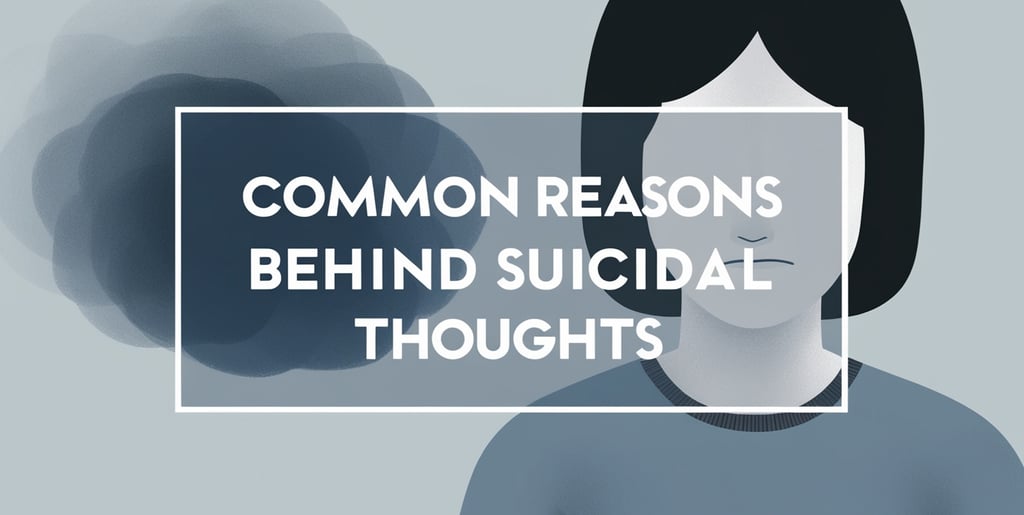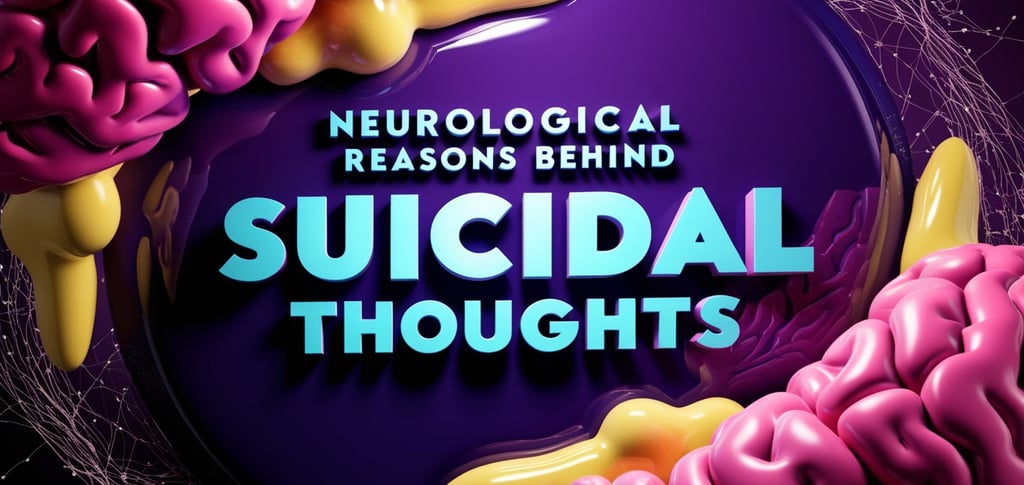HOW DOES SUICIDAL THOUGHT FUNCTION
Suicidal thoughts are deeply rooted in the neurobiological processes of the brain. These thoughts are not simply a sign of weakness or a lack of willpower; rather, they are often the result of a complex interplay between brain regions, neurotransmitters, and environmental stressors. When someone experiences intense emotional pain, the brain’s neural circuits can become overwhelmed and dysregulated, creating a distorted sense of reality and a desire for escape.
One of the key players in this process is the amygdala, the brain’s emotional alarm center. Under extreme stress, the amygdala becomes hyperactive, triggering intense feelings of fear, sadness, and hopelessness. This hyperactivity often occurs alongside dysfunction in the prefrontal cortex — the region responsible for logical thinking, impulse control, and future planning. When this area is under-functioning, it can diminish a person's ability to regulate emotional pain or envision alternatives to suffering.
Central to the biochemical mechanism is the neurotransmitter serotonin, which is widely known to regulate mood, sleep, and appetite. Low levels of serotonin have been strongly linked to depression and suicidal behavior. In fact, research on serotonin dysregulation and suicide demonstrates that imbalances in brain chemistry can severely impair decision-making and heighten emotional pain to unbearable levels.
Additionally, dopamine, a neurotransmitter that influences motivation and reward, is often depleted in individuals experiencing major depressive episodes. This depletion can contribute to anhedonia — the inability to feel pleasure — which further fuels suicidal ideation. Studies on dopamine pathways show how dysfunction in these circuits can cause a person to lose interest in life and feel emotionally numb.
Cortisol, the body's primary stress hormone, is also found in elevated levels in those with chronic stress and trauma. High cortisol levels can damage the hippocampus — a brain region crucial for memory and emotion regulation — further destabilizing mental resilience. For more on this, see The Role of Cortisol in Depression and Suicide.
When all these systems malfunction simultaneously, the brain essentially goes into a crisis state, leading to what neuroscientists refer to as a “suicidal mode” — a condition where the brain is no longer processing reality accurately and begins to seek an immediate solution to relieve unbearable emotional distress, even if it means self-destruction. As outlined in the Neuroscience of Suicidal Thoughts, suicidal ideation is the brain’s desperate attempt to end suffering, not life itself.


Suicidal thoughts often emerge from a complex interaction of psychological, biological, and social factors. One of the most common causes is untreated depression, which can produce persistent feelings of sadness, worthlessness, and emotional agony that overwhelm coping mechanisms. Equally distressing are experiences of trauma and abuse, particularly during childhood, which can leave lasting psychological damage. Individuals suffering from chronic illness or disability may also be vulnerable, especially when pain or physical limitations severely impact their quality of life. In addition, substance abuse impairs judgment and intensifies depression, often increasing impulsive behavior and risk of suicide.
External stressors such as financial hardship or legal troubles, the loss of a loved one, and social isolation also play major roles in driving suicidal ideation. Bullying and cyberbullying, especially among youth, have been linked to serious mental health outcomes. Mental illnesses like bipolar disorder, schizophrenia, and borderline personality disorder significantly heighten the risk of suicide, often due to distorted thinking or emotional dysregulation. Finally, those with impulsive or aggressive personality traits may act on suicidal urges with little warning. Understanding these risk factors is essential to building compassionate interventions and preventing loss of life.
COMMON REASONS BEHIND SUICIDAL IDEATION


People suffer from mental health diseases due to a complex interplay of biological, psychological, social, and environmental factors. Genetics and brain chemistry play a foundational role—individuals with a family history of mental illness are more likely to develop conditions such as depression, anxiety, or bipolar disorder. Scientific research has shown that imbalances in neurotransmitters like serotonin and dopamine can significantly affect mood regulation and emotional stability. For many, these genetic vulnerabilities are triggered by external stressors, leading to the onset or worsening of symptoms. Learn more about the biological causes of mental illness through the National Institute of Mental Health.
Psychological trauma, especially during childhood, is another significant factor. Experiences such as abuse, neglect, loss of a parent, or exposure to violence can leave long-lasting scars on emotional and cognitive development. These unresolved traumas often manifest later in life as mood disorders, personality disorders, or post-traumatic stress disorder (PTSD). The brain, when conditioned to survive under fear or instability, rewires itself in ways that can impair emotional regulation. Professionals recommend trauma-informed approaches and therapy to address such issues, as explored in this guide on trauma and its psychological effects.
Social and economic pressures also play a major role in mental health decline. Chronic stress from unemployment, financial insecurity, discrimination, or lack of social support can trigger or exacerbate mental illness. Urban living, digital overload, and isolation—especially among youth—have been identified as modern contributors to rising rates of depression and anxiety. According to the World Health Organization, these social determinants must be addressed in any meaningful mental health strategy.
Moreover, lifestyle factors such as substance abuse, poor diet, lack of physical activity, and inadequate sleep also significantly impact mental well-being. Drugs and alcohol, for example, can alter brain function and increase vulnerability to disorders like schizophrenia or major depressive disorder. These behaviors can also be a form of self-medication for existing mental health problems, creating a dangerous cycle of deterioration. Health authorities emphasize integrated care models that address both physical and mental health, as detailed in this overview of lifestyle and mental illness.
In sum, mental health disorders are not the result of a single cause but arise from a web of interconnected influences. Understanding this multifaceted nature is crucial to developing compassionate, effective treatment and prevention strategies. By addressing both the internal vulnerabilities and external pressures people face, society can make meaningful progress toward improving global mental well-being.
WHY DO PEOPLE HAVE MENTAL HEALTH ISSUES




Support and Resources
Explore our services for mental health support, awareness, and community connection.


Crisis Hotline Support
Immediate help through crisis hotlines and live chat services available 24/7.
Educational Resources
Access articles, videos, and guides on coping strategies and self-care techniques.
Community Connection
Join forums and support groups to share experiences and find encouragement.